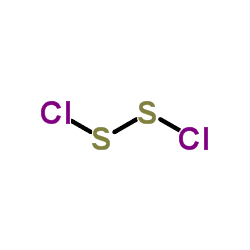Formula S2Cl2 Density 1.69 g/cm³ | Molar mass 135.04 g/mol Boiling point 137.1 °C | |
 | ||
Appearance Light-amber to yellow-red, oily liquid Related sulfur chlorides Related compounds | ||
Sulfur monochloride disulfur dichloride
Disulfur dichloride is the chemical compound of sulfur and chlorine with the formula S2Cl2.
Contents
- Sulfur monochloride disulfur dichloride
- Reaction of water with disulfur dichloride
- Synthesis basic properties reactions
- Reactions
- Applications
- References
Some alternative names for this compound are sulfur monochloride (the name implied by its empirical formula, SCl), disulphur dichloride (British English Spelling) and sulphur monochloride (British English Spelling). S2Cl2 has the structure implied by the formula Cl-S-S-Cl, wherein the angle between the Cla-S-S and S-S-Clb planes is 90°. This structure is referred to as gauche, and is akin to that for H2O2. A different isomer of S2Cl2 is S=SCl2; this isomer forms transiently when S2Cl2 is exposed to UV-radiation (see thiosulfoxides).
This substance is listed in Schedule 3 Part B - Precursor Chemicals of the Chemical Weapons Convention (CWC). Facilities that produce and/or process and/or consume Scheduled chemicals may be subject to control, reporting mechanisms and inspection by the OPCW (Organisation for the Prohibition of Chemical Weapons).
Reaction of water with disulfur dichloride
Synthesis, basic properties, reactions
Pure disulfur dichloride is a yellow liquid that smokes in air due to reaction with water:
It is synthesized by partial chlorination of elemental sulfur. The reaction takes place at usable rates at room temperature. In the laboratory, chlorine gas is led into a flask containing elemental sulfur. As disulfur dichloride is formed, the contents become a golden yellow liquid:
Excess chlorine gives sulfur dichloride which causes the liquid to become less yellow and more orange-red:
The reaction is reversible, and upon standing, SCl2 releases chlorine to revert to the disulfur dichloride. Disulfur dichloride has the ability to dissolve large quantities of sulfur, which reflects in part the formation of polysulfanes:
Pure disulfur dichloride is obtained by distilling the yellow-orange liquid over excess elemental sulfur.
S2Cl2 also arises from the chlorination of CS2 as in the synthesis of thiophosgene.
Reactions
S2Cl2 hydrolyzes to sulfur dioxide and elemental sulfur. When treated with hydrogen sulfide, polysulfanes are formed as indicated in the following idealized formula:
2 H2S + S2Cl2 → H2S4 + 2 HClIt reacts with ammonia to give heptasulfur imide (S7NH) and related S-N rings S8−x(NH)x (x = 2, 3).
Applications
S2Cl2 has been used to introduce C-S bonds. In the presence of AlCl3, S2Cl2 reacts with benzene to give diphenyl sulfide:
Anilines react with S2Cl2 in the presence of NaOH via the so-called Herz reaction to give ortho-aminothiophenolates. These species are precursors to thioindigo dyes. It is also used to prepare the sulfur mustard "gas" by reaction with ethylene at 60 °C (the Levinstein process):
Other uses include manufacturing sulfur dyes, insecticides, synthetic rubbers. Also used in cold vulcanization of rubbers, as polymerization catalyst for vegetable oils and for hardening soft woods.
